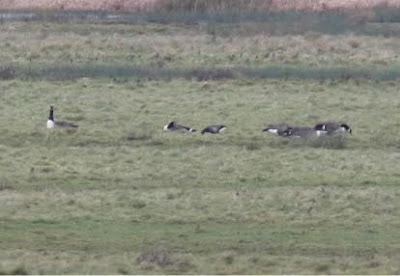 |
| Russian White Fronted Goose (c) Dan Miller |
The year has started with a short cold snap and the
moor has very often been grey, misty and dank. 
As the water levels drop twigs are left with petticoats of ice. (c) Bark
For several days the scrapes and
lagoons were iced over, although there were always some leads of open water.

Lapwings (c) Bark
The latest freeze has had the effect of
reducing the numbers of Lapwings and Golden Plovers on the reserve. Now things
have warmed up it will be interesting to see if the numbers will build up
again.
 |
| Redwing tackling Sloes |
Fieldfares and Redwings have finished the most
palatable of the hedgerow berries and are now either feeding on the ground or tackling
the harder to eat sloes. 
Bullfinch and bramble (c) Bark
Bullfinches are extracting the kernels from the desiccated
blackberries beside the paths to both screens, although mostly what we see is
their white rumps disappearing ahead of us further down the track.

Distant record shot of Brent Goose with Canadas (c) Peter Alfrey
It has been a very birdy start to the year and
already we have recorded eighty-six different species since the first of
January. Geese are doing especially well. The Russian White-fronted Geese are
still on site as are the flock of Barnacles they have been joined by a much scarcer,
black- bellied Brent Goose. Not an uncommon goose around the coast in winter
but more unusual so far from the sea. Three Egyptian Geese have also been on
site.

Hen Harrier disappearing into the murk (c) Bark
There is a Hen Harrier working across the whole moor
It has frequently been seen hunting across The Closes. I was lucky enough on
Sunday to see it land on the grass beside the game strip and could scope it as
it sat on the ground preening. It is a very sleek and elegant bird immaculately
feathered. 
Wigeon Shoveller and Pintail. (c) Bark
A mass of Wigeon feeding out on the flooded Noke Sides were flushed
by a Peregrine and we were able to see it well as it sat at the top of the
barest most skeletal oak tree in the hedge on the other side of the field. This
vantage point would appear to be one of its favourite perches as this was the third
time I have seen it up there in as many visits. From its somewhat smaller size
we think that it is probably a juvenile male. Merlin too is being seen more
frequently but only ever briefly and in flight.
 |
| Wagtails on ice (c) Bark |
There have been up to twenty or so Pied Wagtails picking their way across the ice on Noke sides and with them a similar number of Meadow Pipits. Goldfinches are still gleaning seeds from the clumps of dried out Burdock and Teasels beside the bridleway.
 |
| Goldfinches beside the bridleway (c) Bark |
There are up to forty Chaffinches now coming down to the seed scattered by the hide, along with fifty or so Reed Buntings. There appear to be fewer Linnets coming in this year compared with the last two years. The feeding finches can be very confiding if one waits quietly and patiently by the gate. Amongst them are both male and female Bramblings.
 |
| Cetti's by the second screen (c) Bark |
A Redpoll has been seen near the feeders in the carpark field. An unusual sighting was a Jack Snipe that flushed up from beneath someone’s feet as they walked along the bridleway.
There are still very large numbers of wildfowl across
the whole reserve, Wigeon are the most numerous but significant numbers of Shovellers,
Pintail and Teal are also present. A pair of Goosander were seen and there was
a report of Shelduck. With the three Ring-necked Ducks having left Pit sixty it
will be worth looking carefully through the Tufted Ducks out on the southern lagoon….we
could get lucky!
Waiting for the thaw. (c) Bark





No comments:
Post a Comment